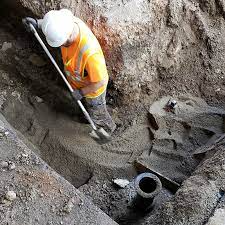Beneath the bustling surface of our cities and towns lies a complex network of essential services that enable our daily lives to function seamlessly. Underground utility work forms the backbone of this hidden infrastructure, encompassing a diverse array of tasks aimed at installing, maintaining, and upgrading the various systems that keep our communities running smoothly. From water and sewage systems to gas and electricity lines, underground utility work plays a crucial role in ensuring the reliability and sustainability of urban environments.
Understanding the Importance:
The significance of underground utility work becomes apparent when one considers the myriad of services it supports. Water supply and sewage systems, for instance, are critical for public health and sanitation. The intricate network of pipes and conduits ensures a continuous and safe supply of clean water while efficiently managing wastewater. Gas lines deliver the fuel that powers our homes and industries, while electrical conduits supply the energy that lights up our lives. Telecommunication cables enable the seamless flow of information, connecting people across the globe. To ensure the continuous and efficient operation of these systems, meticulous attention is paid to the planning, installation, and maintenance of underground utilities.
Challenges of Underground Utility Work:
While the benefits of underground utility work are undeniable, the process comes with its own set of challenges. Excavating beneath the ground introduces complexities not encountered in above-ground construction. One of the primary challenges is the need for precise planning and coordination to prevent conflicts between different utility systems. Accidental damage to existing infrastructure during excavation can lead to service disruptions, safety hazards, and costly repairs. Consequently, utility companies and construction teams must collaborate closely to map out existing underground networks and plan projects meticulously.
Technological Advancements:
As technology continues to advance, so does the efficiency and precision of underground utility work. Modern tools such as ground-penetrating radar, sonar, and advanced mapping software enable professionals to accurately locate existing utilities and plan new installations with greater precision. These technologies not only enhance the safety of excavation but also contribute to the overall sustainability of the process by minimizing the environmental impact.
Trenchless Technology:
One notable advancement in underground utility work is the adoption of trenchless technology. Traditionally, utility installation involved extensive excavation, disrupting roadways and landscapes. Trenchless methods, such as horizontal directional drilling (HDD) and microtunneling, minimize surface disruption by allowing utilities to be installed underground without the need for large trenches. This not only reduces the environmental impact but also minimizes disruptions to traffic and communities.
Environmental Considerations:
The environmental impact of underground utility work is a significant concern. Excavation activities can disturb soil and vegetation, potentially leading to erosion and habitat disruption. Additionally, the use of heavy machinery and construction materials may contribute to air and noise pollution. To mitigate these environmental effects, many utility projects incorporate sustainable practices, such as erosion control measures, reforestation initiatives, and the use of eco-friendly construction materials. These considerations not only align with environmental regulations but also contribute to the long-term health of the communities in which these projects take place.
Safety Measures:
Ensuring the safety of both workers and the public is paramount in underground utility work. Excavation activities pose inherent risks, and precautions must be taken to prevent accidents. Strict safety protocols, proper training, and the use of personal protective equipment are standard practices in the industry. Furthermore, communication and coordination between utility companies, construction crews, and local authorities are essential to managing potential hazards and emergencies effectively.
Regulatory Compliance:
Underground utility work is subject to a myriad of regulations and standards to ensure the safety, reliability, and sustainability of the infrastructure. Local, state, and federal agencies set guidelines for excavation, construction, and environmental protection. Adherence to these regulations is not only a legal requirement but also an ethical responsibility to safeguard public well-being and the environment.
Economic Impact:
Beyond its intrinsic value in supporting essential services, underground utility work plays a crucial role in economic development. Reliable utility infrastructure attracts businesses, facilitates urban growth, and enhances property values. Conversely, poorly maintained or outdated utility systems can impede economic progress and result in costly repairs and service disruptions. Municipalities and utility companies must invest in the continuous improvement and modernization of underground infrastructure to support the long-term prosperity of their communities.
Conclusion:
In conclusion, underground utility work is an intricate and indispensable aspect of urban infrastructure that often goes unnoticed. Its importance lies not only in the installation and maintenance of essential services but also in the careful consideration of environmental impact, safety, and adherence to regulations. As technology continues to evolve, the field of underground utility work will undoubtedly see further advancements, contributing to more sustainable, efficient, and resilient urban environments. Appreciating the complexity and significance of what lies beneath our feet allows us to recognize the dedication and expertise required to ensure the seamless functioning of the vital systems that sustain our communities. Visit official website spragueexcavating.com

